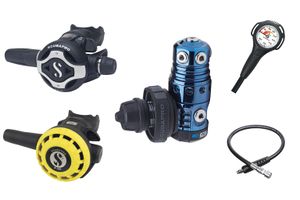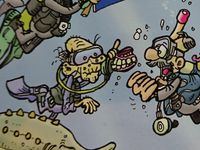Regulator
A regulator is an essential part of your scuba set. It reduces the high pressure of the tank to the ambient pressure and supplies the diver with air at the best possible breathing comfort in any given depth.
The most common regulator in sports diving is a two-stage single-hose regulator. The pressure reduction takes place in two structurally separate stages, which are connected with a medium-pressure hose.
Before your first dive
Your regulator will supply you with all the air you need under water. You can breathe normally and you don't have to be afraid that something could break if you have a cough through it etc. When you put a regulator in your mouth, remember to always exhale to clear any water that might be inside.
- Warning
Please note, do never hold your breath while diving, but breathe normal as you would on the surface. Remember, the regulator provides you with all the air you need in any given depth.
Basic knowledge for Open Water Diver* (OWD*)
Components and purpose
To supply a diver under water with air from the diving cylinder, a regulator usually reduces the cylinder pressure in two stages to ambient pressure. It consists of the following components:
First stage
The first stage reduces the cylinder pressure to a preset intermediate pressure of about 9 bar above the respective ambient pressure.
The first stage has high pressure ports (labeled HD or HP) for the pressure gauge, and medium pressure ports (labeled MD or LP) for the main second stage, the octopus, and the inflator hose.
The first stage is connected to the cylinder valve via a hand wheel (DIN connection). Sometimes also a bow connection (INT connection) is used, which is however much more prone to failure. Between both systems there are corresponding DIN-INT adapters.
Second stage
The second stage is connected to the first stage using a intermediate pressure hose. The second stage reduces the intermediate pressure from the first stage to breathable ambient pressure. It consists of housing (metal or plastic), mouthpiece, exhaust valve, deflector and purge button.
In order to prevent water from entering the second stage during the dive, exhaust valve and deflector must always point downwards. Never take a regulator upside down in your mouth.
The regulator set must come with two first stages, one main and a backup (octopus) on a longer hose.
Main second stage
The main second stage is usually the second stage you are diving with.
Alternate second stage
The alternate second stage or octopus is an additional second stage, equivalent to the main second stage of the regulator. It is intended as an aid to the diver, if its main first stage fails or an out of air situation of a buddy. For that reason, it is equipped with a longer medium pressure hose to ensure freedom of movement. Usually, both the hose as well as the octopus are yellow.
In an out of air situation the one in need usually takes the octopus from his dive partner. In technical diving, cave diving and cold water diving you usually dive with your alternate second stage on a long hose and have the main hanging on a silicone necklace right in front of your mouth. That way, the diver in distress doesn't need to look for a hidden alternate air source and he is sure to get a working second stage since it has been just in use. Ideally when the emergency has been clarified between the divers, the second stages are exchanged. The distressed diver gets the octopus with the extended hose, the helper uses his main.
The octopus must come from the same manufacturer as the rest of the regulator set. Combinations of components from different manufacturers are not permitted for product liability and compatibility reasons.
Submergible pressure gauge (SPG)
The SPG is a mechanical or electronic indicator showing the current cylinder pressure, indicating the remaining air supply. It is mounted on the high-pressure connection (marked as HD or HP) of the first stage of the regulator using a high-pressure hose or an electronic transmitter.
The pressure is displayed in Bar. In US territories the pressure is measured in psi (pound per square inch, 200 bar corresponds to 2900 psi). The display range is up to 50% higher than the operating pressure, i. e. it goes up to 300 bar and some even to 450 bar. The range from 0 to 50 bar is marked in color as an indication of reserve.
To prevent pressure surges when opening the cylinder valve and to reduce the amount of air escaping in the event of a defect, a throttle is build into the high-pressure hose. While opening the valve, hold the pressure gauge pointing to the floor to avoid injuries in case of a failing gauge.
Inflator hose
The inflation hose is connected to a intermediate pressure outlet of the first stage. It is used to fill the BCD or drysuit with air by the inflator.
With the quick coupling, you can connect the inflator even under pressure.
Mounting
How to mount your regulator onto your scuba set, you can find in the article scuba set.
Care and maintenance
After the dive you should rinse your equipment in fresh water. This is especially important with the regulator, as salt causes corrosion. It is important that no water enters the first stage, as the valves are open inside when not pressurized.
For rinsing, proceed as follows:
- Seal the first-stage high-pressure inlet with your thumb and dip it several times in clean fresh water. A swinging back and forth has only small effect. Better you dip them several times, take them out again and let them drain.
- You wash the second stages in the same way, but without panning, because modern regulators have very low closing pressures. Never press the purge button because that will open the valve and water may enter the medium pressure hoses and find its way into the first stage.
- If possible, pressurize the regulator and dry it by pressing the purge button.
- Let the regulator dry in the shade without folding the hoses.
- If there is no clean rinse option on holiday, then pack the regulator until the next dive with a closed first stage so that it can not dry. This prevents salt from crystallizing and building up on essential parts of the first stage.
The second stage should be disinfected at regular intervals, especially if it is used in divecenter operation constantly changing divers.
The warranty period for new equipment is two years. However, it only applies if it is used as intended and only if the service intervals prescribed by the manufacturer have been met. For example, these are usually one year or 100 dives for regulators. Normal wear and tear and the connected parts are excluded from warranty.
Service is a matter of trust, because you trust your regulator under water with your life. The employees of the service centers make appropriate courses with the manufacturers and must work exactly according to the manufacturer's specifications. There are enough hobbyists who think they can make such repairs themselves. Maybe they even have the capability and the original spare parts. However, there remains the legal risk: manipulating your own regulator has no legal consequences. But if you give it to somebody or lent it to someone, you have to take over the product liability. This means, in the event of an accident, the person who has worked on the regulator must prove that this manipulation was not the trigger of the accident. Even if you do not lend your regulator, you should not tinker with it yourself, but give it to a dealer for service or repair.
Malfunction
In general, you should never use your regulator if it behaves abnormally, it leaks, bubbles, has a high resistance to breathing, etc. In this case, take it to a specialist for service or repair.
Icing: During diving, icing of the regulator may occur. For this reason, only regulators suitable for cold-water may be used at water temperatures below +10°C. For safety and deeper dives, two equivalent regulators should also be mounted on a double tank valve. If the main regulator is frozen up, it can be shut off by the diver or its buddy at the cylinder valve and continue breathing from the secondary regulator on the second outlet on the same cylinder. An octopus, which is connected to the same first stage as the main, is of little help in a fully blowing second stage due to a frozen first stage because the cylinder will be empty in a very short time.






